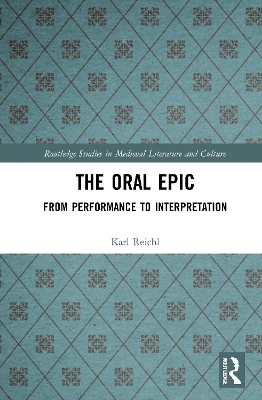
The Oral Epic
Routledge (Verlag)
978-1-032-03808-7 (ISBN)
This book focuses on the performance of oral epics and explores the significance of performance features for the interpretation of epic poetry.
The leading question of the book is how the socio-cultural context of performance and the various performance elements contribute to the meaning of oral epics. This is a question which not only concerns epics collected from living oral tradition, but which is also of importance for the understanding of the epics of antiquity and the Middle Ages which originated and flourished in an oral milieu.
The book is based on fieldwork in the still vibrant oral traditions of the Turkic peoples of Central Asia and Siberia. The discussion combines fieldwork with theory; it is not limited to Turkic epics but branches out into other oral traditions.
Karl Reichl is Professor Emeritus of the University of Bonn (Institute of English, American and Celtic Studies). He has had visiting professorships at Harvard University, the Hebrew University of Jerusalem, the École Pratique des Hautes Études in Paris, the University of Madison at Wisconsin, and the Karakalpak State University in Nukus. His main research interests lie in medieval oral literature and in contemporary (or near-contemporary) oral epic poetry, especially in the Turkic-speaking areas of Central Asia.
Introduction
Part I: Settings
1 How to Identify an Oral Epic
Oral: shades and grades
The challenge of native classification
An African interlude
The Uzbek dastan
2 The Singer
Epic singers: types and terms
How to become an epic singer
The chain of transmission
Creativity and innovation
3 Introducing Performance
The ethnography of communication
Textualization
Part II: Performance
4 Voice
Speaking
Singing
Shamanic voices
5 Gesture
Conventional gestures: the Karakalpak jïraw
Stylized gestures: the Kyrgyz manaschï
Gesture and inspiration
Gesture, miming, stage props
6 Oral Epics as Songs
Song as vehicle, song as music
‘Riding the song’: the singing of the Kyrgyz epic Manas
Music and metre: some examples
7 Voice and Instrument
Gusle, qobïz, horse-head fiddle
Lute, dutar, dombira
The interplay of song and instrument
Part III: Interpretation
8 Words, Music, Meaning
Meaning and expression
What’s in a name?
Imitation
Leitmotifs in Siberian oral epics
Expression and convention
9 The Singer and the Tale
Point of View
Mythological epics, sacred time
First-person narration, shamanic traces
The narrator’s presence in the narrative
10 Performance and Interpretation
Visualization and imaging
Aria and recitative
From context to text
Appendices
A Notes on Oral Epic Traditions
B Audio/Video Examples
C Discography
| Erscheinungsdatum | 17.07.2023 |
|---|---|
| Reihe/Serie | Routledge Studies in Medieval Literature and Culture |
| Zusatzinfo | 3 Tables, black and white; 40 Halftones, black and white; 40 Illustrations, black and white |
| Verlagsort | London |
| Sprache | englisch |
| Maße | 152 x 229 mm |
| Gewicht | 453 g |
| Themenwelt | Literatur ► Lyrik / Dramatik ► Lyrik / Gedichte |
| Kunst / Musik / Theater ► Musik | |
| Geisteswissenschaften ► Sprach- / Literaturwissenschaft ► Anglistik / Amerikanistik | |
| Geisteswissenschaften ► Sprach- / Literaturwissenschaft ► Literaturwissenschaft | |
| Geisteswissenschaften ► Sprach- / Literaturwissenschaft ► Sprachwissenschaft | |
| ISBN-10 | 1-032-03808-X / 103203808X |
| ISBN-13 | 978-1-032-03808-7 / 9781032038087 |
| Zustand | Neuware |
| Informationen gemäß Produktsicherheitsverordnung (GPSR) | |
| Haben Sie eine Frage zum Produkt? |
aus dem Bereich


